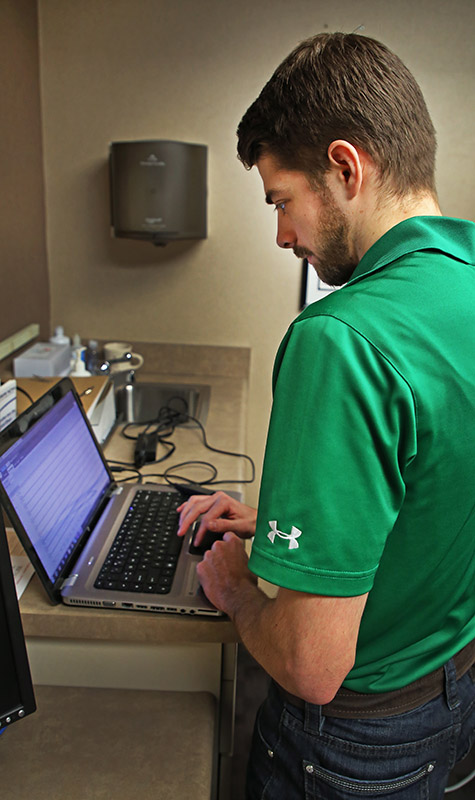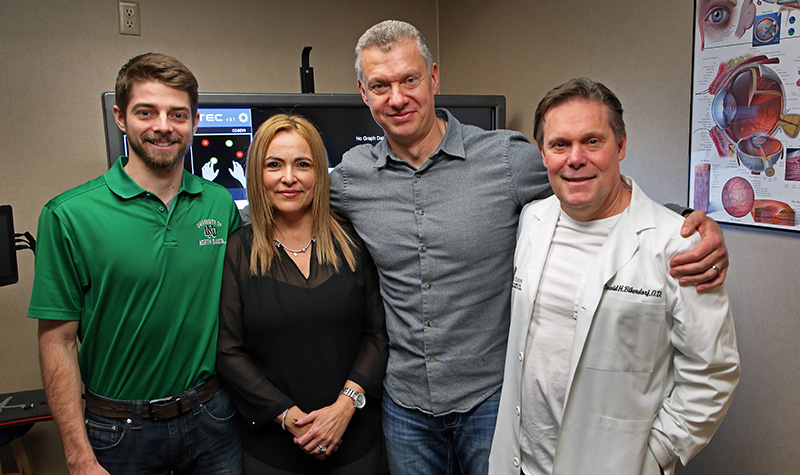17 Feb UND research provides new approach to help athletes recover from and avoid concussions

Wearing sensors connected to an EEG measuring brain wave activity, Dmitri Poltavski demonstrates the Nike Sensor Training Station used to test athletes for his research on diagnosing and treating concussions. Photo by Patrick C. Miller/UND Today.
Some of the same techniques that can help diagnose concussions in athletes and measure their recovery can also be used to help athletes perform better in sports.
An article coauthored by Dmitri Poltavski, a University of North Dakota associate professor of psychology, and published in November in Scientific Reports, a Nature research journal, found that the lingering effects of a concussion can affect an electroencephalogram (EEG)-derived index of short-term memory on tasks of visuomotor control, making the impacts more subtle and difficult to measure than standard neuropsychological tests indicate.
By using tests measuring the visual responses of athletes and monitoring their brain waves, the researchers demonstrated these techniques can not only better determine when it’s safe for an athlete to return to sports after a concussion, but also find ways to improve their athletic performance.
“We’re trying to equip athletes to be in charge of their own prevention by retraining their visual system and tapping into the brain’s ability to restructure itself,” Poltavski said. “This can provide a sensory buffer for athletes to avoid potential impacts that may result in concussions. We want to change the outcomes from within – not just to treat – but also to prevent future occurrences.”
Concussion impacts

Kyle Bernhardt, a UND Ph.D. student . Photo by Patrick C. Miller/UND Today.
A key finding of the research showed that those with a history of concussion have persistent deficits in psychomotor ability – the brain signals driving physical actions. The negative effects of a concussion include reduced visual processing speed, lowered working-memory function, difficulty concentrating and sustaining focused attention, poor decision-making and less stress regulation.
“People who suffer concussions do not recover all of their functions,” Poltavski said. “For example, they get tired easily from reading or from looking at a computer screen. They have sensory overload, get headaches and may get vertigo. Many of those problems can be addressed through systematic retraining of the visual system, and that’s what we’re trying to do.”
The paper cites Center for Disease Control and Prevention statistics showing that each year, concussions represent 5 to 9 percent of all sports-related injuries. This means the number of concussions suffered by athletes annually is between 1.6 million and 3.8 million. Even more troubling, the statistics show those with a history of concussions are two to nearly six times more likely to receive another concussion.
The published study examined 81 youth athletes between the ages of 13 and 18, some with a history of concussion. A battery of visual response tests on a Nike Sensory Training Station was used to measure working memory, decision-making ability and motor output requirements, such as hand/eye coordination. Brainwave activity during the tests was measured and recorded using a wireless EEG.
Research results
The results suggest that athletes with a history of concussion have persistent deficits in psychomotor ability, which has implications for diagnosis, rehabilitation and athletic training.
“Our technique could be used diagnostically and can be used in conjunction with sports vision training programs to produce greater customization and make this type of training more efficient for athletes,” Poltavski said. “It could also be a good diagnostic and monitoring index of recovery of one’s function when going through concussion treatment programs.”
Using the technique to train the brain to react more quickly not only improves athletic performance, but also helps athletes avoid potential concussions.
“Our training isn’t restricted to rehabilitating a function,” Poltavski noted. “You may have good visual function, but we can train you to the point where you become better, which translates into better performance in sports. It shows the relationship between those type of skills and actual athletic performance.”

Conducting research, therapy and training on athletes with concussions are, from the left are Kyle Bernhardt, Carolina Praus Poltavski, Dmitri Poltavski and David Biberdorf. Photo by Patrick C. Miller/UND Today.
For the past decade, Poltavski has collaborated with David Biberdorf, a practicing developmental optometrist with Valley Vision Clinic in Grand Forks, N.D. He’s also a grant-funded vision scientist and a fellow in the College of Optometrists. Biberdorf and Poltavski have coauthored a number of research papers, including the one recently published in Scientific Reports.
Along with Poltavski’s wife, Carolina, an optometric vision therapist in the UND psychology department, the three have formed Advanced Neuro-Vision Systems, a research-based visual assessment, rehabilitation and training program to restore neurological function following mild traumatic brain injury.
Testing hockey players
About 10 years ago, Poltavski and Biberdorf began studying concussed male and female UND hockey players who passed tests showing they could return to play, but continued to experience subtle visual issues and other problems.
“We found there was something wrong in their focusing,” Biberdorf said. “The testing methods became more and more sophisticated, so that we can now further investigate these areas. We can determine who had a past history of concussion based on ocular-motor performance, electro-diagnostic performance and EEG responses.”

Carolina and Dmitri Poltavski discuss the results of his vision tests on the Nike Sensory Training Station. She is an optometric vision therapist in the UND Department of Psychology. Photo by Patrick C. Miller/UND Today.
The results of the research went beyond diagnosing and rehabilitating concussed athletes.
“We could tell who played offense and who played defense based on their vision scores, not ever having seen the players skate,” Biberdorf said. “We could use the vision tests to predict goals scored and points per game. That’s how it all emerged.”
In diagnosing and treating concussions, Poltavski recommends that healthcare professionals pursue a comprehensive approach that goes beyond basic physical therapy.
“Don’t restrict the evaluation to the domains of your profession,” he advised. “Recognize that there are deficits that affect multiple systems. This awareness should result in greater cooperation among professionals, including physical therapists, athletic trainers, neuropsychologists, vision professionals and neurologists. These professions should be actively talking to each other and providing continuity of care, which will result in comprehensiveness of care.”


